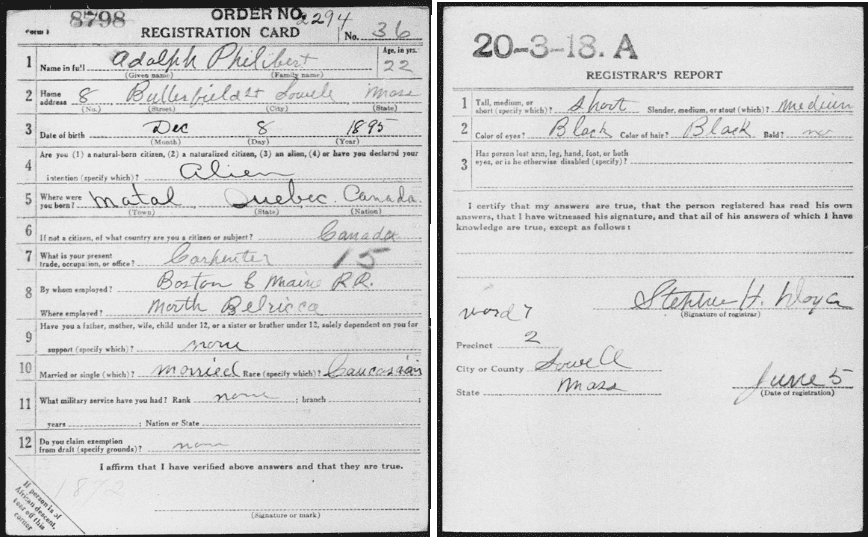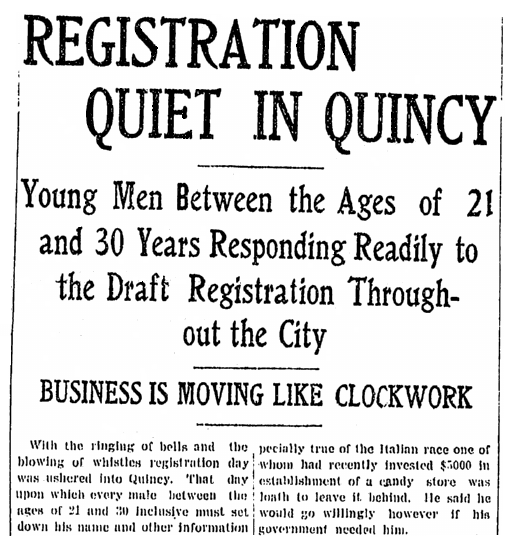Introduction: In this article – part of an ongoing “Introduction to Genealogy” series – Gena Philibert-Ortega shows how much important family history information is contained in World War I draft registration records. Gena is a genealogist and author of the book “From the Family Kitchen.”
We discussed in the previous article some of the history of the World War I Draft Registration (see: Genealogy 101: #19 Learning More about World War I Draft Records, Part I). Now we’ll examine the three WWI draft registrations themselves. Pay particular attention to who was registered on what date to better understand what information might exist about your ancestor.
Databases with images from the World War I Draft Registration can be found on FamilySearch and several genealogy subscription websites.

First Registration Day: 5 June 1917
The first draft registration for World War I of men ages 21 through 30 years of age was held on 5 June 1917 (registration days for Alaska, Hawaii, and Puerto Rico were different than the continental U.S.). Their birthdates ranged from 6 June 1886 to 5 June 1896.

Draft Registration Cards filled out on that first day included the following questions:
- Name
- Home address
- Date of birth
- Are you: (1) natural-born citizen, (2) a naturalized citizen, (3) an alien, or (4) have you declared your intention?
- Where were you born? (Town) (State) (Nation)
- If not a citizen, of what country are you a citizen or subject?
- What is your present trade, occupations, or office?
- By whom employed? Where employed?
- Have you a father, mother, wife, child under 12, or a sister or brother under 12, solely dependent on you for support (specify which)?
- Married or single (which)? Race (specify which)?
- What military service have you had? Rank, Branch, Years, Nation or State
- Do you claim exemption from draft (specify grounds)?
Participants also answered a few questions on the back of the card, including:
- Tall, medium or short (specify which)?
- Color of eyes? Color of hair? Bald?
- Has the person lost arm, leg, hand, foot, or both eyes, or is he otherwise disabled (specify)?
Your ancestor may have had questions about the draft. Those living in the U.S. were confused about who had to register. For example, what about men who were not citizens, or just visiting the U.S.?
One place they found answers was the local newspaper. This newspaper article, printed one day prior to the first registration, answers questions about citizenship and age to help readers determine their eligibility for the draft.
Second Registration Day: 5 June 1918 & Supplemental Registration Day: 24 August 1918
One year after the first registration day, the second registration on 5 June 1918 was for men who had turned 21 since the first registration. Birthdates for these men fell between 6 June 1895 and 5 June 1897.
These men were asked some of the same questions from the previous registration, but were also asked:
- Father’s birthplace: (city or town) (State or province) (Nation)
- Name and place of employment (No.) (Street) (city or town) (State)
- Name and address of nearest relative
- Race: White, Negro, Indian, or Oriental
Third Registration Day: 12 September 1918
The third and last registration day occurred just two months before the end of World War I. The men registered included those born between 13 September 1872 and 24 August 1897, 25 August 1897 and 12 September 1900, and those who didn’t register previously born between 6 June 1886 and 24 August 1897.
Interestingly, the above newspaper article makes it very clear what would happen to those men who did not register as required:
“Failure to register is punishable by one year in prison, a fine of $1,000 and induction into the army immediately after the [prison] term is completed.”
Questions asked for this last registration included:
- (First Name) (Middle Name) (Last Name)
- Permanent home address
- Age in years
- Date of birth
- Race: White, Negro, Oriental, Indian Citizen, Indian Non citizen
- S. Citizen: Native born, Naturalized Citizen by father’s naturalization before registrant’s majority, Alien Declarant, Non declarant
- If not a citizen of the U.S., of what nation are you a citizen or subject?
- Present occupation, Employer’s name
- Place of employment or business
- Nearest relative: Name, address
Start Searching Now!
Like the decennial U.S. census, World War I Draft Registration records provide genealogists with a look at their ancestor at a specific place and time. Information found on the World War I draft cards should be followed up with additional documents like vital records, city directories, and the newspaper.
Genealogy Tips for World War I Draft Registration Records
- Remember that if your ancestor was already serving in the military, he would not be represented in the draft registration.
- This is a good index for men born between 1872 and 1899.
- Remember that a man may have filled out a draft registration and later served in the military – but filling out a draft registration card doesn’t necessarily mean he served.
- Men were registered who lived in the states and then-territories Alaska and Hawaii, as well as Puerto Rico.
- Card registrations done in Puerto Rico are in Spanish.
- Men who were aliens and visitors were even registered, so if your ancestor was just visiting the U.S. during the time of the registrations, look for a possible draft card.
Related Articles:
